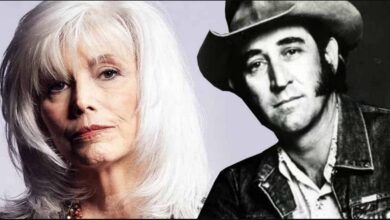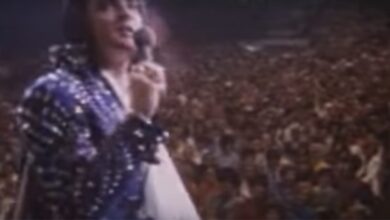This Popular Dance From The 1950s, Do You Remember It Today
In February 1958, a dance craze known as “The Stroll” swept through American high school gyms and sock hops, capturing the vibrant spirit of youth and the burgeoning rock ‘n’ roll scene. It epitomized the carefree nature of the era, and its appealing simplicity made it a staple at social gatherings. The Stroll originated in African American communities, reflecting a rich tradition of dance that celebrated both community and individual expression. Its widespread popularity was significantly driven by its feature on television, particularly on Dick Clark’s influential show, “American Bandstand,” which introduced the dance to a national audience. Teenagers everywhere wanted to join in the fun, turning local hangouts into dynamic dance halls.
The structure of The Stroll was distinct and engaging, as it involved two lines of dancers facing each other, creating an aisle down the center. Couples would take turns strutting down this aisle to the infectious rhythm of the music. This format allowed for both group camaraderie and personal flair, giving each dancer an opportunity to showcase their unique style. It became a platform for individuality amidst the collective energy of the group, symbolizing the increasing desire among teenagers to express themselves against the backdrop of a rapidly evolving society.
Music played a critical role in the success of The Stroll, particularly the rendition by The Diamonds. This vocal group from Canada, known for their smooth harmonies and doo-wop style, captured the spirit of the dance with their hit song, “The Stroll.” With Dave Somerville’s rich baritone leading the way, the song became an upbeat anthem that resonated with the hearts of the youth. The Diamonds’ performance brought credibility and a sense of fun to the dance, transforming it into an iconic part of the 1950s music landscape. Their ability to blend catchy tunes with engaging performance styles helped to solidify The Stroll as a cultural phenomenon that transcended boundaries.
As The Stroll gained traction, it emerged as much more than a mere dance; it became a symbol of youthful exuberance and a rising sense of independence among teenagers. The dance allowed young people to experience a sense of belonging while also fostering an environment of playful competition. With each performance, dancers showcased their creativity and style, all while enjoying the thrill of the music. This captured the essence of the 1950s, a time marked by social change and cultural shifts that encouraged self-expression among America’s youth.
The Stroll also played a significant role in bridging cultural divides during an era characterized by segregation. It transcended racial and socioeconomic boundaries, bringing together teenagers from various backgrounds who were eager to embrace the joyous spirit of dance and music. The accessibility of The Stroll’s movements meant that anyone could learn and participate, fostering a sense of unity within the community. It was common to see diverse groups of young people coming together in celebration, dancing in unison under the dim lights of gymnasiums and dance halls.
The popularity of The Stroll reached its zenith as it became a quintessential part of high school events, sock hops, and teen gatherings. From prom nights to birthday parties, the dance was a main attraction that guaranteed laughter, joy, and memorable moments. Teens showcased their best outfits, embodying the fashionable spirit of the era while strutting their stuff down the aisle. This playful competition became part of the allure of The Stroll, as each dancer sought to impress their peers with their moves.
As the dance became entrenched in pop culture, it made its way into movies, television, and record charts. The energy surrounding The Stroll was infectious, and it inspired many young people to practice the dance in their living rooms. The visual representation of the dance on screen drew in even more fans, propelling the culture of rock ‘n’ roll to new heights. The Stroll stood as a testament to the joy that music and dance could bring, forming bonds and creating lasting memories among those who participated in the fun.
Furthermore, The Stroll’s influence persisted beyond the 1950s. The dance left an indelible mark on subsequent generations, with echoes of its rhythm and style appearing in later music and dance trends. It paved the way for future line dances, demonstrating that simple movements and social interaction could be the heart of a successful dance craze. The legacy of The Stroll lives on in the celebratory nature of dance, showcasing how music can serve as a unifying force.
Dave Somerville, the lead singer of The Diamonds, played an integral role in this cultural moment. Born in 1933 in Toronto, Canada, he helped shape the sound of the group with his compelling vocal presence. Somerville’s contributions to doo-wop and pop music are part of a broader narrative of the 1950s, where artists like him laid the groundwork for future musicians. His charisma and stage presence made him a beloved figure among fans, and his interpretation of “The Stroll” became synonymous with the excitement of youth culture during this dynamic period.
Ultimately, The Stroll was more than a mere dance; it was a celebration of youth, freedom, and unity during a time of transformation in America. Its ability to bring people together across divides made it a cherished aspect of 1950s culture, leaving a legacy that continues to inspire and energize dance floors today. The combination of The Stroll’s catchy music, engaging dance format, and the spirit of community it fostered ensures its place as a timeless classic in the annals of American pop culture history.
?si=CbHsPwTM-VodZAIG





